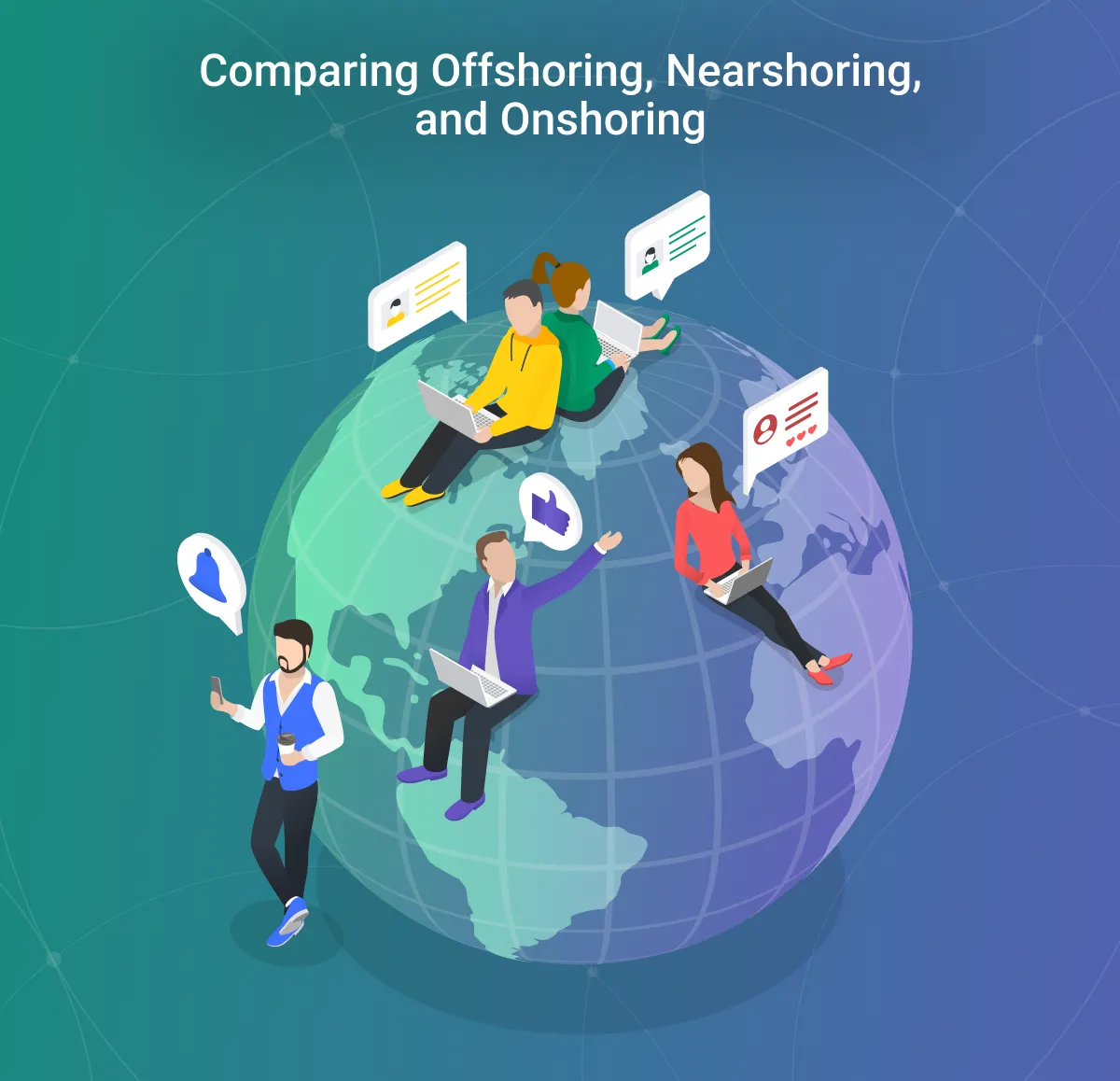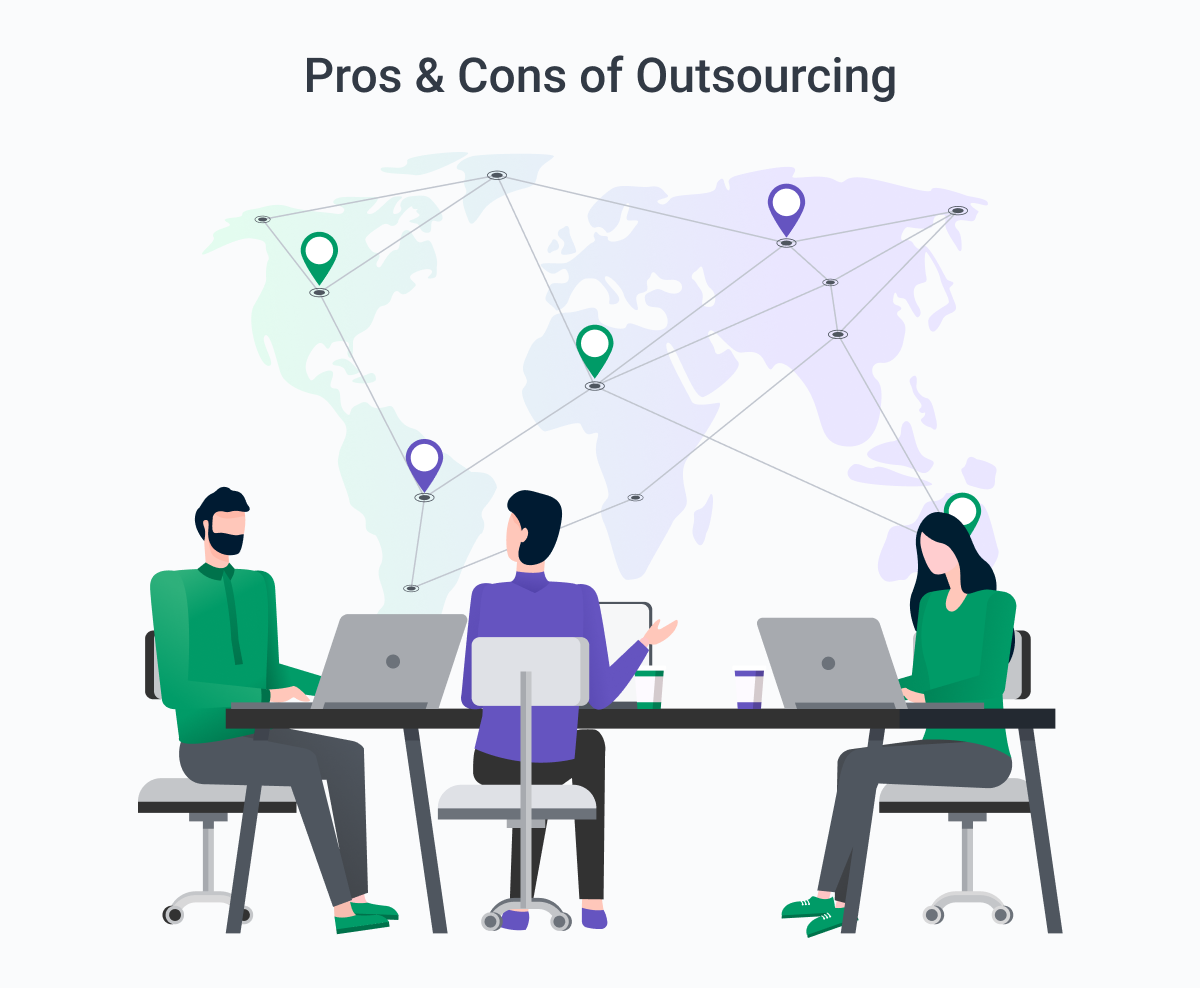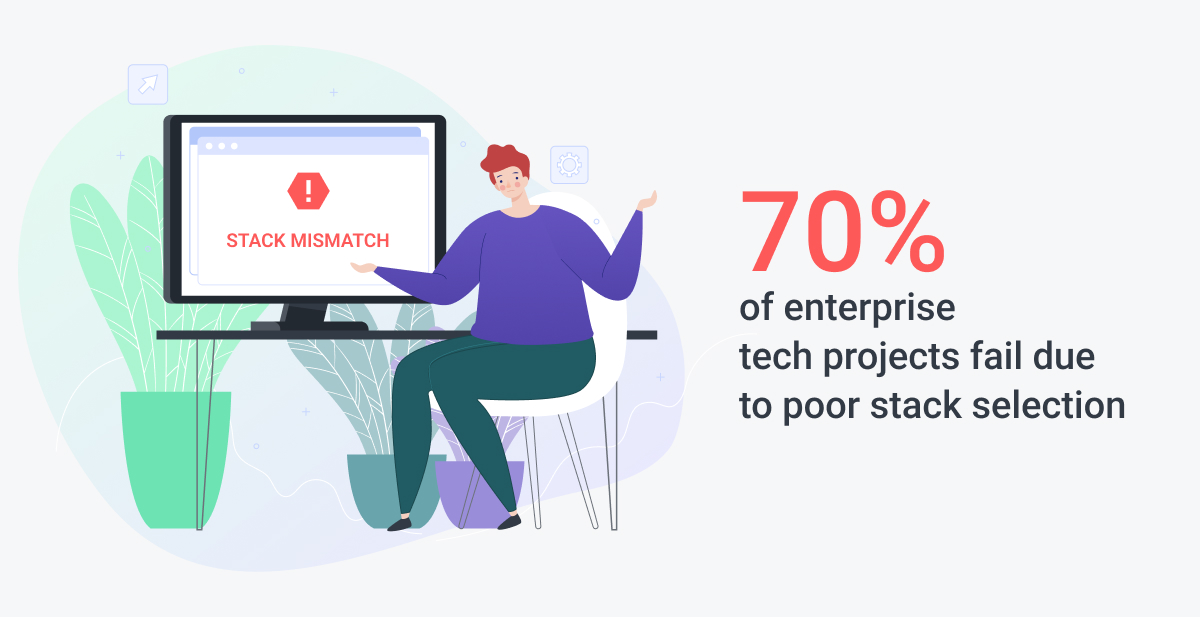The global software development landscape has undergone a fundamental shift. Companies that once viewed outsourcing as a cost-cutting measure now recognize it as a strategic advantage for accessing world-class talent, accelerating innovation, and scaling efficiently.
Softjourn has been helping clients bring their ideas to fruition for over 17 years, with 87% of companies experiencing gaps in their IT teams turning to outsourcing to prevent production bottlenecks.
This comprehensive guide provides you with everything you need to successfully navigate outsourced software product development. You'll discover proven frameworks for vendor selection, project management strategies that ensure quality delivery, and real-world case studies demonstrating how companies have achieved remarkable results through strategic outsourcing partnerships.
Key takeaways you'll gain:
- How to assess your outsourcing readiness and select the optimal engagement model
- Proven vendor evaluation criteria that separate exceptional partners from mediocre providers
- Communication and project management strategies that eliminate common outsourcing pitfalls
- Legal and intellectual property protection frameworks for international partnerships
- Real-world case studies showing successful long-term outsourcing relationships
Understanding Outsourced Software Development
The foundation of successful outsourcing begins with a clear understanding of what it entails and how it differs from traditional development approaches. Let's explore the key concepts that will guide your outsourcing strategy.
What Is Outsourced Software Product Development
Outsourced software product development involves partnering with external teams or companies to design, build, and maintain your final product. Unlike traditional service outsourcing, product development outsourcing focuses on creating complete solutions that drive your business forward, not just completing tasks.
The distinction matters because product development requires deep understanding of your business objectives, user needs, and market dynamics. Your development partner becomes an extension of your team, contributing strategic insights alongside technical expertise.

Types of outsourcing models:
Offshore outsourcing leverages teams in distant countries, often providing significant cost savings but requiring careful management of communication and cultural differences. Countries like Ukraine, India, and the Philippines have emerged as major offshore destinations.
Nearshore outsourcing partners with teams in neighboring countries or similar time zones, balancing cost efficiency with easier collaboration. For US companies, this often means working with teams in Latin America or Canada.
Onshore outsourcing engages domestic teams, providing premium service with minimal barriers but at higher costs. This model is well-suited for highly regulated industries or projects that require frequent in-person collaboration.
The Current Outsourcing Landscape
The global software outsourcing market has matured significantly, with quality and expertise now distributed worldwide. The allure of outsourcing has seen a substantial rise in its popularity, especially in a globalized economy where talent and expertise are spreading across continents.
Eastern European countries, such as Ukraine and Poland, have gained a reputation for their robust technical education systems and expertise in complex software development. Latin American countries offer nearshore advantages for North American companies, while Asian markets continue to provide cost-effective solutions at scale.
Quality has improved dramatically across all regions. Modern outsourcing product development companies invest heavily in process improvements, certifications, and talent development. Many now offer the same quality standards as domestic teams while providing additional benefits like 24/7 development cycles and specialized expertise.
Common Misconceptions And Realities
❌ Misconception: Outsourced development always means lower quality.
✅ Reality: Quality depends on partner selection and management, not location. Many outsourcing companies maintain higher quality standards than in-house teams, as they focus on repeatability and client satisfaction.
❌ Misconception: Communication barriers make outsourcing too difficult.
✅ Reality: Modern communication tools and practices have largely eliminated these barriers. Successful outsourcing teams invest in English proficiency and cultural training for their teams.
❌ Misconception: You lose control over your project when outsourcing.
✅ Reality: Proper contracts, communication frameworks, and project management actually provide more visibility and control than many in-house projects.
Assessing Your Outsourcing Readiness
Before diving into vendor selection, ensure your organization is prepared for a successful outsourcing partnership. This assessment involves evaluating your internal capabilities, project requirements, and success criteria.
Internal Capability Audit
Before engaging an outsourcing provider, you need a clear understanding of your internal capabilities and gaps. Start by mapping your current technical team's skills against your project requirements. Identify areas where you lack expertise, capacity, or both.
Evaluate your project management maturity. Successful outsourcing requires strong project management capabilities on your side. You'll need to clearly communicate requirements, manage timelines, and coordinate between internal and external teams.
Assess your collaboration culture. Companies with open, communicative cultures tend to succeed with outsourcing, while those with rigid hierarchies or poor internal communication often struggle with external partnerships.
Project Suitability Analysis
Not every development project is ideal for outsourcing. Projects well-suited for outsourcing include:
- Well-defined technical requirements with clear success criteria
- Projects requiring specialized skills not available internally
- Large-scale development efforts that would strain internal resources
- Maintenance and enhancement of existing systems
- Projects with flexible timelines that can accommodate communication cycles
Projects better kept in-house include:
- Highly experimental or rapidly changing projects requiring constant pivoting
- Projects involving sensitive intellectual property or trade secrets
- Small projects where the outsourcing overhead exceeds the work itself
- Projects requiring deep integration with internal business processes
Defining Success Metrics
Establish clear metrics before beginning your outsourcing partnership. Technical metrics should include code quality measures, performance benchmarks, and security standards. Project metrics should cover timeline adherence, budget compliance, and deliverable completeness.
Communication metrics are equally important. Track response times, meeting attendance, and the quality of progress reports. Business impact metrics should measure how the outsourced development contributes to your overall business objectives.
.png)
Choosing The Right Outsourcing Model
With your readiness assessment complete, the next critical decision involves selecting the engagement model and geographic approach that best aligns with your project requirements and organizational culture.
Outsourcing Engagement Models
Project-based outsourcing works well for clearly defined projects with fixed scope, timeline, and budget. This model provides predictability but offers limited flexibility for changes. It's ideal for standalone projects or when you have detailed specifications.
The dedicated development team model provides a long-term partnership, where you essentially rent a team that works exclusively on your projects. Tacit Corporation chose this model with Softjourn, starting with a team of 3 resources and growing to a strong team of 20 spanning Web, iOS, Android, .Net and QA over 12+ years. This model offers maximum flexibility and control but requires more management overhead.
Staff augmentation fills specific skill gaps in your existing team. You maintain control over project management while gaining access to specialized expertise. This model works well when you have strong internal project management but need additional technical capabilities.
Hybrid approaches combine multiple models to optimize for different project phases or requirements. For example, you might use project-based outsourcing for initial development and switch to staff augmentation for ongoing maintenance.

Geographic Considerations
Offshore outsourcing provides maximum cost savings and access to large talent pools. However, it requires careful management of time zone differences and cultural variations. Success depends on establishing clear communication protocols and building strong relationships over time.
Nearshore outsourcing offers a balanced approach, providing cost benefits while minimizing communication barriers. For US companies, Latin American partners often provide cultural alignment and overlapping business hours.
Onshore outsourcing enables the elimination of geographic barriers, but it comes at a premium price. This model works well for highly regulated industries or when frequent in-person collaboration is essential.

Vendor Types And Selection Criteria
Full-cycle Development companies, such as Softjourn, offer comprehensive services with established processes and diverse expertise. Softjourn has assisted companies from more than 20 countries in reducing their development costs while maintaining the desired level of quality and control. These partners can handle complex, long-term projects and provide strategic guidance.
Boutique specialists focus on specific technologies or industries, offering deep expertise in narrow areas. They're ideal when you need cutting-edge skills in emerging technologies or industry-specific knowledge.
Large-scale providers offer extensive resources and global reach but may lack the personal attention and flexibility of smaller partners. They work well for very large projects or when you need guaranteed capacity.
Vendor Selection And Evaluation
The vendor selection process represents one of the most critical phases of your outsourcing journey. A systematic approach to evaluation will help you identify partners who can deliver exceptional results while building lasting relationships.
Creating Your Vendor Shortlist
Start your vendor search by leveraging industry networks, professional associations, and referrals from trusted contacts. Research potential partners through their websites, case studies, and online presence. Look for partners with relevant industry experience and technical expertise in your required technologies.
Initial screening criteria should include:
- Relevant experience in your industry or technology stack
- Company size and stability appropriate for your project scope
- Geographic and time zone compatibility with your requirements
- Initial cultural and communication fit based on early interactions
Comprehensive Vendor Evaluation
Technical assessment goes beyond reviewing portfolios. Conduct technical interviews with key team members who would work on your project. Request detailed case studies that demonstrate problem-solving capabilities and technical depth.
When Tacit Corporation evaluated partners, they were "impressed by Softjourn's technical expertise and direct approach". Look for partners who ask insightful questions about your requirements and offer constructive suggestions for improvement.
A portfolio review should focus on projects and case studies similar to yours in terms of complexity and scope. Pay attention to the business outcomes achieved, not just technical implementation. Request references from clients with similar projects and speak with them directly about their experience.
Due Diligence Process
Financial stability verification protects you from partners who might fail mid-project. Review audited financial statements, check credit ratings, and assess the company's growth trajectory. Look for partners with diverse client bases rather than over-dependence on a few large clients.
Legal and compliance verification becomes critical for international partnerships. Verify business registrations, professional certifications, and compliance with relevant regulations. For financial or healthcare projects, ensure your partner meets industry-specific compliance requirements.
Intellectual property protection policies should be clearly documented and legally enforceable. Review standard contracts, confidentiality agreements, and IP assignment clauses. Ensure your partner has experience protecting client IP and can demonstrate their commitment to security.
Making The Final Selection
Pilot projects provide the best way to evaluate a potential partner's capabilities. Softjourn's approach involves asking the right questions and involving people with the right experience in conversations. Structure pilot projects to test key aspects of your full project while limiting risk and investment.
Create scoring frameworks that objectively compare vendors across technical, commercial, and relationship factors. Weight the criteria based on your project's specific requirements and risk tolerance.

Project Planning And Requirements Definition
Once you've selected your software development company, the success of your project depends heavily on thorough planning and clear requirements definition. This phase sets the foundation for everything that follows.
Requirements Gathering And Documentation
Clear requirements are the foundation of a successful outsourcing partnership. Invest significant time in documenting not just what you want built, but why you want it built and how success will be measured. Utilize techniques such as user story mapping, acceptance criteria definition, and prototype development to ensure a shared understanding.
Technical specifications should be detailed enough to guide development but flexible enough to accommodate better solutions your partner might suggest. Include architecture decisions, technology stack preferences, and integration requirements with existing systems.
Create requirements documents that serve as both specifications and communication tools. Use visual aids, diagrams, and examples to supplement written descriptions. Plan for requirements evolution and establish change management processes early.
Project Scope And Timeline Definition
A work breakdown structure should decompose your project into manageable components that can be independently estimated, developed, and tested. This structure becomes the foundation for timeline estimates, resource allocation, and progress tracking.
Effort estimation benefits from your partner's experience with similar projects. However, validate estimates against your own understanding and include appropriate buffers for unexpected complexities. Softjourn's approach involves thorough data analysis to determine which tools are needed to develop a fully functioning solution and provide input necessary to set out a detailed project plan and timetable.
Risk identification should cover technical, business, and relationship risks. Develop mitigation strategies for high-impact risks and establish early warning systems to detect problems before they escalate into critical issues.

Technology Stack Decisions
Balance innovation with proven solutions when selecting technologies. Your outsourcing partner's recommendations carry significant weight due to their breadth of experience, but ensure alignment with your long-term technology strategy and internal capabilities.
Scalability considerations become critical for product development. Choose technologies and architectures that can grow with your business rather than requiring complete rewrites as you scale. Consider factors like performance under load, ease of adding new features, and availability of skilled developers.
Integration requirements with existing systems often drive technology decisions. Map out all integration points early and ensure your chosen technologies can handle the required data flows and communication protocols.
Budget Planning And Cost of Outsourcing Product Development
Fixed-price vs. time-and-materials pricing each offers distinct advantages. Fixed price provides budget predictability but requires very detailed specifications and may include premiums for uncertainty. Time and materials offer flexibility but require more active cost management.
Hidden costs can significantly impact your budget. Account for project management overhead, communication tools, additional testing requirements, and potential scope changes. Include buffers for currency fluctuation if working with international partners.
Payment schedules should align with project milestones and deliverable completion. Avoid large upfront payments, but ensure your partner has adequate cash flow to execute the project effectively.
Setting Up Effective Communication And Collaboration
A successful product development process hinges on establishing robust communication frameworks and collaboration processes. These systems become the backbone of your partnership and directly impact project outcomes.
Communication Infrastructure
Modern communication tools have largely eliminated geographic barriers to collaboration. However, the selection and usage of tools significantly impact project success. Establish primary communication channels for different types of interactions: instant messaging for quick questions, video calls for complex discussions, and project management tools for formal updates.
Documentation standards ensure information is accessible to all team members regardless of time zone differences. Maintain shared repositories for requirements, architectural decisions, and project status. Use collaborative documentation tools that allow real-time editing and version control.
Time zone management requires intentional planning when working with distributed teams. Softjourn worked very closely with Tacit to understand the dynamics of the combined team in Canada and Ukraine. Establish core overlap hours for real-time collaboration while designing asynchronous processes for independent work.
Project Management Methodologies
Agile development adapts well to outsourced environments when properly implemented. Regular sprints, daily standups, and retrospectives maintain team cohesion and project momentum. However, distributed agile requires more discipline in communication and documentation than co-located teams.
Scrum ceremonies need modification for distributed teams. Daily standups might become recorded updates for teams in non-overlapping time zones. Sprint planning and retrospectives become more important for maintaining team alignment and continuous improvement.
The key is selecting development methodologies that match your project's requirements and your team's capabilities rather than forcing inappropriate frameworks onto your partnership.
Roles And Responsibilities
Clear accountability prevents confusion and conflicts between internal and external team members. Define decision-making authority, escalation procedures, and communication protocols. Establish who has final authority on technical decisions, requirement changes, and quality acceptance.
Project manager responsibilities should be clearly divided between your in-house development team and your offshore development team. Some companies prefer to maintain control over project management, while others delegate this responsibility to their partner. The choice depends on your internal capabilities and comfort level with external project management.
Building Team Cohesion
Virtual team building becomes essential for long-term partnerships. Brenda Crainic from Tacit highlighted how Softjourn provided support for their professional growth and workplace satisfaction. Invest in relationship building through regular video calls, shared celebrations of milestones, and cultural exchange activities.
Cross-cultural communication requires sensitivity and adaptability from both sides. Understand your partner's cultural norms around communication styles, decision-making processes, and conflict resolution. Provide cultural orientation for your internal team members who will work closely with the outsourced team.

Managing Development And Quality Assurance
With communication frameworks established, your focus shifts to overseeing the actual development lifecycle and ensuring that quality standards are met throughout the project.
Software Development Process Oversight
Code review processes maintain quality standards and knowledge sharing between teams. Establish clear coding standards, review procedures, and approval workflows. Use automated tools to enforce basic standards while focusing human review and audit on architectural decisions and business logic.
Version control and deployment procedures should be established early and followed consistently. Implement continuous integration pipelines that automatically build, test, and deploy code changes. This automation reduces manual errors and provides consistent feedback on code quality.
Performance monitoring should begin during development rather than waiting for production deployment. Establish performance benchmarks and regularly test against them throughout the product engineering process. Address performance issues early when they're easier and cheaper to fix.
Quality Assurance Strategies
Testing methodologies must account for distributed development teams and potentially complex integration requirements. When engaging in software development outsourcing, several best practices for effective QA and testing should be considered, including establishing clear and comprehensive requirements and ensuring both the client and vendor have a shared understanding of expected outcomes.
Implement multiple levels of testing: unit tests for individual components, integration tests for system interactions, and end-to-end tests for complete user workflows. Automated testing becomes especially important in distributed environments where manual testing coordination is more complex.
User acceptance testing coordination requires careful planning when working with external teams. Establish clear acceptance criteria, testing procedures, and mechanisms for collecting feedback. Plan for multiple testing cycles and allocate sufficient time for issue resolution within your project timeline.
Progress Monitoring And Reporting
Dashboard creation provides real-time visibility into project status for all stakeholders. Include metrics for development progress, quality indicators, and budget tracking. Ensure dashboards are accessible to all team members and updated automatically whenever possible.
Regular status meetings maintain alignment and address issues before they become problems. However, avoid meeting overload that reduces productive development time. Focus meetings on decision-making, problem-solving, and strategic alignment rather than status updates that could be communicated asynchronously.
Change Management
Scope changes are inevitable in software development, but they require careful management in outsourced projects. Establish clear procedures for requesting, evaluating, and approving changes. Softjourn's experienced teams managed various aspects of integrated services, ensuring everything was meticulously designed for success before each deployment.
An impact assessment should cover technical complexity, timeline implications, and budgetary effects. Require detailed analysis of proposed changes before approval. Consider the cumulative effect of multiple small changes, which can significantly impact project scope.
Please accept cookies to access this content
Case Study: Tacit Corporation's 12-Year Partnership Success
Tacit Corporation's long-term partnership with Softjourn demonstrates how strategic outsourcing can evolve into a true business partnership. Starting with a team of three resources, mainly in .NET and Web Development, they currently have a very strong team of 20 spanning Web development, .NET, QA, and iOS and Android app development.
Initial engagement strategy: Tacit began with a focused engagement, testing Softjourn's capabilities on core technologies before expanding the relationship. This approach enabled both companies to establish trust and understanding while minimizing initial risk.
Scaling approach: The team evolved over time, and Softjourn worked very closely with Tacit to understand their needs, the dynamic of the combined team in Canada and Ukraine and provided support for their professional growth and workplace satisfaction. Rather than simply adding more outsourced developers, the partnership evolved to meet Tacit's changing business needs.
Technical achievements: The Softjourn team developed and helped certify most of Tacit's integrations with over 60 third-party systems, including point-of-sale systems, payment gateways, loyalty and gift card systems, player cards, student cards, lockers, and, most recently, autonomous stores. This demonstrates how a strong outsourcing partnership can handle increasingly complex technical challenges.
Business impact: Brenda Crainic, CTO of Tacit, emphasized, "We grew a lot as a company over the last 12 years, and our processes changed; many of the current development practices are being initiated by the team". The outsourced team became true partners in business growth rather than just service providers.
Key success factors:
- Long-term commitment from both parties created stability for relationship building
- The evolutionary approach allowed the partnership to adapt to changing business needs
- Cultural integration between the Canadian and Ukrainian teams created a unified development culture
- Technical excellence built trust that enabled expansion into more critical business areas
Case Study: Fintech Integration Complexity
A leading company's fintech integration project with Softjourn demonstrates how collaborating with an outsourced, experienced product team can effectively navigate complex technical challenges that would overwhelm less skilled teams.
Challenge scope: The client needed to integrate with numerous services, including banks, data aggregators, analytics platforms, and payment processors, such as those from US Bank, Wise, and Finicity. Each integration presented unique technical and compliance challenges.
Complexity factors: To integrate with Wise, a significant amount of work was required in the client's system to store all payments, support multiple currencies, and implement validation, before even sending a request. The project required extensive system modifications rather than simple API connections.
Strategic approach: Softjourn helped map the client's architecture, identified gaps, made necessary modifications, and then performed the REST API calls. This systematic approach ensured successful integration while maintaining system stability.
Partnership value: By working with a service provider, the client was able to offer a seamless experience for their consumers while saving time, effort, and money. The outsourcing partnership provided both technical expertise and project management capabilities that the client lacked internally.
Business outcomes: The successful integrations enabled the client to offer expanded services to their customers, directly contributing to business growth and competitive advantage. The partnership began in 2011, and since then, they've worked together to update existing iOS and Android apps, design and develop a white-label mobile app, and undertake a variety of other projects.
Risk Management And Mitigation
Every outsourcing partnership involves inherent risks that must be identified, assessed, and actively managed. Understanding these risks and implementing appropriate mitigation strategies protects your investment and ensures project success.
Common Outsourcing Risks
Communication breakdowns remain the most common cause of outsourcing project failures. These typically result from unclear requirements, insufficient communication protocols, or cultural misunderstandings rather than language barriers.
Quality issues often stem from misaligned expectations rather than a lack of technical capability. Prevent these issues by establishing clear quality standards, implementing regular review processes, and conducting early prototype validation.
Timeline delays can cascade through interconnected project components. Build realistic timelines with appropriate buffers, and establish early warning systems to identify potential delays before they impact critical milestones.
Vendor dependency risks emerge when you become too reliant on a single software engineering partner. While long-term partnerships offer significant benefits, it is essential to maintain some internal capabilities and backup vendor relationships for critical business functions.
Risk Prevention Strategies
Comprehensive contracts should address potential issues before they occur. Include service level agreements, performance metrics, intellectual property protections, and termination procedures. However, don't rely solely on contracts to manage relationships—they should support good communication and mutual trust rather than replace them.
Regular audits of both technical deliverables and process compliance help identify issues early. Conduct code reviews, security assessments, and process evaluations on a regular schedule rather than waiting for problems to emerge.
Knowledge documentation ensures continuity even if team members change. Require comprehensive documentation of code, processes, and business logic. Maintain this documentation throughout the project rather than treating it as an end-of-project deliverable.
Crisis Management
Escalation procedures should be clearly defined and well-understood by all parties. Establish multiple levels of escalation and ensure decision-makers are available when needed. Practice escalation procedures in less critical situations to ensure they are effective when truly needed.
Vendor replacement strategies might become necessary despite careful selection and management. Maintain relationships with backup vendors and ensure your contracts include reasonable termination and transition clauses. However, use these strategies as a precaution rather than as active management tools.
Legal Considerations And Intellectual Property
Navigating the legal landscape of international outsourcing requires careful attention to contracts, intellectual property rights, and regulatory compliance. These foundational elements protect your business interests and ensure smooth partnership operations.
IP Ownership And Protection
Copyright and patent considerations vary significantly across different jurisdictions. Ensure your contracts clearly specify that you own all intellectual property developed for your project. Consider how existing open-source components and third-party libraries affect IP ownership.
Work-for-hire agreements provide the clearest IP ownership structure but may not be legally enforceable in all jurisdictions. Supplement these agreements with explicit IP assignment clauses that transfer ownership upon creation rather than relying solely on employment relationships.
Trade secret protection requires careful handling of confidential information. Implement secure communication channels, limit access to sensitive information, and ensure your development provider has appropriate security measures in place.
Contract Essentials
Service level agreements should specify measurable performance standards, monitoring procedures, and remedies for non-compliance. Focus on outcomes rather than activities—measure what matters to your business success.
Confidentiality provisions must be comprehensive and enforceable. Cover not just technical information but also business strategies, customer data, and competitive information. Include provisions for data handling, storage, and destruction.
Termination clauses should provide reasonable notice periods and transition assistance. Include provisions for knowledge transfer, code handover, and ongoing support during transition periods.
Data Protection And Privacy
GDPR, CCPA, and other privacy regulations create specific obligations for data handling regardless of where your partner is located. Ensure that your partner understands these requirements and has the necessary procedures in place.
Cross-border data transfer requirements vary by regulation and destination country. Research applicable requirements and implement appropriate safeguards such as standard contractual clauses or adequacy decisions.
Security breach notification procedures should be clearly defined and tested. Ensure your partner can detect, contain, and report security incidents within required timeframes.
Best Practices And Success Strategies
Drawing from years of successful outsourcing partnerships, certain patterns and approaches consistently lead to better outcomes. These best practices can significantly improve your chances of outsourcing success.
Relationship Management
Long-term partnerships offer significant advantages over transactional relationships. Tacit's 12+ year partnership with Softjourn demonstrates how relationships can evolve from simple outsourcing to strategic partnership. Invest in relationship building and mutual understanding rather than focusing solely on individual project success.
Performance evaluation should be regular, comprehensive, and two-way. Evaluate not just technical deliverables but also communication effectiveness, problem-solving capability, and strategic contribution. Provide feedback that helps your partner improve their service to you.
Contract renewal and renegotiation offer opportunities to refine partnership terms based on experience and evolving needs. Use these discussions to address any issues that have emerged and to align the partnership with your evolving business strategy.
Continuous Improvement
Lessons learned documentation should be captured throughout projects rather than only at completion. Regular retrospectives help identify what's working well and what could be improved. Share these insights with your outsourcing partner to drive mutual improvement.
Process optimization based on project outcomes helps streamline future collaborations. As Tacit's CTO noted, "many of the current development practices being initiated by the team" shows how partnerships can drive process innovation.
The evolution of your technology stack should be a collaborative process with your outsourcing partner. Leverage their experience across multiple clients to identify emerging technologies and best practices that could benefit your business.
Success Metrics And Measurement
ROI calculation should include both direct cost savings and indirect benefits such as faster time-to-market, access to specialized skills, and increased development capacity. Many companies find that the strategic benefits exceed the product development cost savings.
Quality improvements often result from partnering with specialists who focus exclusively on software development. Track metrics like defect rates, performance improvements, and user satisfaction to quantify these benefits.
Time-to-market acceleration can provide significant competitive advantages. Measure how outsourcing affects your product release cycles and ability to respond to market opportunities.
Common Pitfalls And How To Avoid Them
Over-specification can stifle innovation and increase costs. Provide clear requirements but allow your outsourcing partner to suggest better solutions based on their experience.
Micromanagement destroys the benefits of outsourcing by requiring excessive oversight time and preventing your partner from working efficiently. Establish clear expectations and measure outcomes rather than activities.
Unrealistic expectations about timelines, costs, or capabilities often lead to project failures. Base expectations on realistic assessments and your partner's demonstrated capabilities rather than ideal scenarios.
Future Trends And Considerations
The outsourcing landscape continues to evolve rapidly, driven by technological advances, changing business needs, and global market dynamics. Understanding these trends helps you prepare for future opportunities and challenges.
Emerging Technologies And Outsourcing
AI and machine learning development requires specialized expertise that many companies lack internally. Outsourcing these capabilities allows access to cutting-edge skills without the time and cost of building internal teams.
Cloud-native development and DevOps practices are becoming standard expectations rather than differentiators. Ensure your development partners have strong capabilities in these areas and can help modernize your development practices.
Blockchain and cryptocurrency projects require deep technical knowledge and regulatory understanding. Partner with specialists who have proven experience in these rapidly evolving areas.
Market Evolution And Predictions
Geographic shifts in outsourcing destinations continue as education systems improve and wage levels change. Eastern Europe, Latin America, and Southeast Asia are all growing as preferred destinations for high-quality outsourced product development services.
Quality improvements across all outsourcing destinations mean that geographic arbitrage based solely on cost is becoming less relevant. Focus on finding the best capabilities for your specific needs rather than simply the lowest costs.
The remote work impact on outsourcing dynamics has been significant. The normalization of remote work has reduced barriers to outsourcing while also intensifying global competition for talent.
Preparing For The Future
Building adaptable outsourcing strategies that can evolve with changing technology and business needs ensures long-term success. Avoid rigid approaches that can't accommodate new opportunities or challenges.
Technology trend monitoring should be a collaborative effort with your outsourcing partners. Leverage their exposure to multiple clients and projects to identify trends that could impact your business.
Internal team skill development alongside outsourcing ensures you can effectively manage partnerships and make strategic technology decisions. Maintain core capabilities while leveraging external expertise for specialized needs.
Conclusion And Next Steps
Successful outsourced software product development requires more than finding a good vendor at a reasonable price. It demands strategic thinking, careful planning, and active relationship management. The companies that achieve the best results view outsourcing as a strategic partnership rather than a simple service transaction.
The most critical success factors are:
- Clear communication and well-defined expectations from the beginning
- Strong project management capabilities on both sides of the partnership
- Cultural compatibility and mutual respect between teams
- Long-term relationship perspective that goes beyond individual projects
- A continuous improvement mindset that drives better outcomes over time
Implementation Roadmap
30 days: Assessment and preparation
- Complete internal capability audit and project suitability analysis
- Define success metrics and evaluation criteria
- Research potential outsourcing partners and create initial shortlist
- Establish budget parameters and timeline expectations
60 days: Vendor selection and contracting
- Conduct comprehensive vendor evaluations and technical assessments
- Complete due diligence process and reference checks
- Negotiate contracts and establish communication frameworks
- Plan pilot project or initial engagement phase
90 days: Project launch and optimization
- Execute pilot project and evaluate partnership effectiveness
- Refine communication and project management processes
- Scale successful partnerships to larger projects
- Establish ongoing relationship management procedures
Key Warning Signs To Watch For
- Communication deterioration: Delayed responses, unclear status updates, or increasing miscommunications
- Quality degradation: Increasing defect rates, performance issues, or user satisfaction problems
- Timeline slippage: Repeated deadline misses without adequate explanation or corrective action
- Cultural misalignment: Persistent conflicts over processes, expectations, or working styles
- Vendor dependency: Over-reliance on a single partner without backup options or internal capabilities
Success in outsourced software development stems from treating it as a strategic partnership that requires investment, attention, and a mutual commitment to excellence, rather than merely as a cost reduction measure. Companies that approach outsourcing with this mindset achieve remarkable results that extend far beyond simple cost savings.
Your next step should be completing the internal readiness assessment outlined in this guide. Understanding your own capabilities, requirements, and objectives provides the foundation for all subsequent decisions about outsourcing partnerships.
The future belongs to companies that can effectively leverage global talent and expertise while maintaining control over their strategic objectives. Outsourced software development, when done well, provides exactly this capability—access to world-class expertise that accelerates innovation and drives business growth.
Additional Resources
For comprehensive vendor evaluation: Use the evaluation frameworks and checklists provided in this guide, but adapt them to your specific industry and technical requirements.
For ongoing relationship management: Establish regular review cycles and continuous improvement processes from the beginning of your partnership rather than waiting for problems to emerge.
For legal and compliance guidance: Consult with attorneys experienced in international technology contracts and your specific industry regulations.
The investment you make in properly planning and managing your outsourcing partnerships will pay dividends throughout the relationship and set the foundation for long-term business success.















